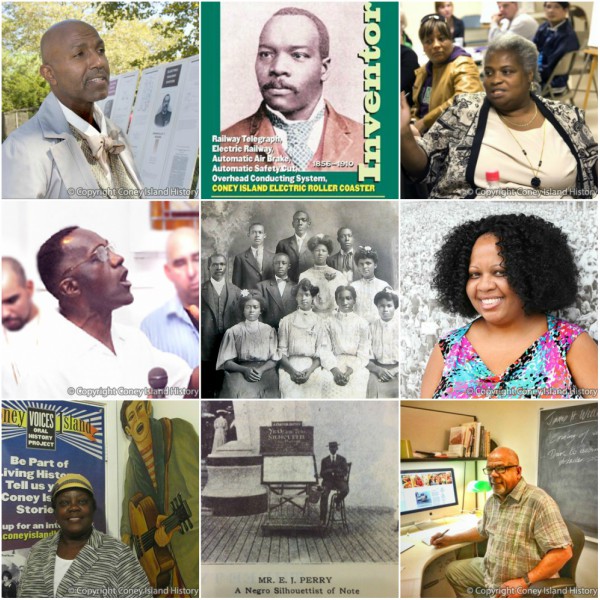
In celebration of Black History Month, take a moment and listen online to these interviews from the Coney Island History Project Oral History Archive featuring historic figures, authors, and community leaders.
David Head, a retired NYC Transit worker and former chairman of the Black History Committee for TWU Local 100, tells the story of African-American inventor Granville T. Woods (1856-1910). "I came across a courageous pioneer who pressed on with his dreams during a very difficult historical period of race relations," he says. "As I began to look deeper into the life of this man, I became truly amazed by his achievements." Among Woods' many electrical patents was one for the world's first electric roller coaster, which was located in Coney Island a century ago. Head was instrumental in having a street across from Coney's Stillwell Avenue Subway Terminal renamed "Granville T. Woods Way."
Historian Eric K. Washington rediscovers African American artist E.J. Perry, who was called "America's most famous silhouette cutter" by The Billboard in the early 20th century. Perry had a concession at Coney Island's Luna Park, where it was said "he is there with a nice spiel and and he cuts your picture with the scissors in a minute." The silhouettist also worked at Coney Island's Dreamland, the 1904 St. Louis World's Fair and the 1907 Jamestown Exposition. "I think he's still an enigma, but bit by bit he's getting clearer," says Washington. "I think a bigger story or a popular story could easily come out of this man's life."
When Ronald Stewart recorded this interview in 2007, he had lived in Coney Island for exactly half a century. He has worked as the director of a youth program and a parole officer, owned a local bookstore and barber shop, and is a community activist. When he was a boy, his family was forced out of their bungalow home by Fred Trump's "urban removal" to build Trump Village. He recounts his childhood and the various places he has lived in Coney, including Mermaid Houses, O'Dwyer Houses, West 33rd Street, and his current home, one of the houses built by Astella Development.
Mathylde Frontus grew up in Coney Island as the eldest child of Haitian immigrant parents and is currently an adjunct assistant professor at Columbia School of Social Work. In 2004, she founded Urban Neighborhood Services (UNS), a small multi-service agency on Mermaid Avenue that offers services in the areas of housing, employment, legal referral, financial literacy, counseling, and youth leadership. In addition to her work as UNS’s executive director through 2016, Frontus is also the founder and outgoing chair of the Coney Island Anti-Violence Collaborative – a coalition of stakeholders working to reduce gun violence in the Coney Island community.
Shirley Aikens has called Coney Island her home for nearly 40 years and is president of the Carey Gardens Tenants Association and a member of Community Board 13 and the NYPD's 60th Precinct Community Council. Aikens recounts moving to Carey Gardens with her one-year-old daughter in the 1970s, her first impressions of Coney Island, and how it has changed over the years. For ten years she worked at Astroland Park, where she enjoyed her jobs as a water race game operator and boardwalk arcade manager. Aikens talks about the need for jobs for teens under 18 and a parking garage in the amusement area to alleviate summer traffic
Alfie Davis has lived in Coney Island for nearly 40 years and is the Tenant Association Leader of the Sea Rise I complex in Coney Island's West End. Part I of her family's story illuminates an incredible chapter of African-American history. Originally from South Carolina and Florida, the family migrated north to New York City in the 1930s and lived together on West 108th Street and later in Queens. When Davis first moved to Coney Island in 1980, her friends on Brooklyn's Pacific Street said "Are you going to live on top of a roller coaster?" because "nobody knew that there was anything developed in Coney island except the amusement park."
Economic development specialist Georganna Deas is a Coney Island resident and advocate who has lived in the Gravesend Houses on Kaiser Park for forty years. After moving here in 1977, she worked with Coney Island Pride and then with Astella Development. Deas recalls advocating for a one-fare zone and against the privatization of Coney Island Hospital. Among the transformations she has seen are fires blighting the neighborhood, Astella building over 1,000 houses on the vacant lots, and the rezoning plan of the Coney Island Development Corporation.

Add new comment